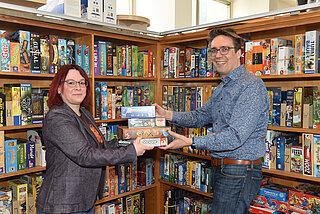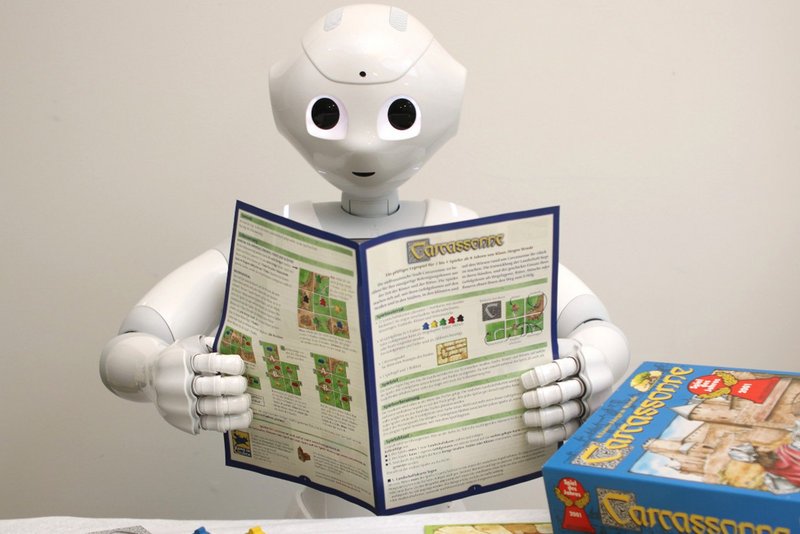
Digital X-ray of the world of games
Professor Voit examines the world of games with EMPAMOS
By Thomas Tjiang
It’s not always easy to describe what makes some games fascinating. Sometimes it’s the idea of the game, sometimes its design or feel. The best way to explain it is to get caught up in playing the game yourself. Dr Thomas Voit, professor at the Georg Simon Ohm University of Applied Sciences Nuremberg, goes one step further. In the German Games Archive in Nuremberg, he plays games with his students in order to digitally record the most diverse elements. They then have the computer evaluate the data gathered on layouts and elements.
A new dimension for ToyCity Nuremberg

The conditions in ToyCity Nuremberg are ideal for once again breaking new ground in this field. The Faculty of Computer Science of the University of Applied Sciences Nuremberg is making a digital X-ray of the huge collection of the German Games Archive in Nuremberg, which has more than 40,000 board and parlour games. Launched in 2016, the joint research project EMPAMOS is dedicated to the Empirical Analysis of Motivating Game Design Elements. In the meantime, it is providing valid data on how the elements of collecting, rewarding or time limits are combined in a game, for example. “This is how we’re finally going to get a topography or map for the world of games,” says Dr Thomas Voit, the Dean of the Faculty of Computer Science.
100 game elements identified
To establish the digital dataset, the research team first played games properly. Sitting around the game table, they come up with hypotheses about which elements are included and how they develop their motivating effect when played in certain combinations. So it’s also possible to see what goes wrong with a game if certain elements are missing. For example, if the dice are missing in “Ludo” or if everyone could determine the number shown on the dice themselves without any element of chance, the game would quickly lose its appeal. The research team has already compiled a catalogue of a good 100 game elements. You probably don’t need more than that; all that’s left now is to find variants or ‘composite molecules’, as Voit calls them.
For example, the research team has empirically documented an average of 24 to 25 game elements for family games such as “Labyrinth”. For complex expert and strategy games, the number of elements can be easily twice that. Even for games for three- to six-year-olds, the digital evaluation came up with 12 to 15 elements – something that surprised the computer scientist and keen game-player somewhat. “If you look at things closely, you can discover how intricately the game elements are all coordinated with each other. I take my hat off to the creativity of the game designers.”
Digital pattern recognition for cooperative games
Digital pattern recognition reveals recurring combinations from the wealth of game instructions. Voit illustrates this with the example of cooperative games, e.g. the dice games “Orchard” or “Magic Maze”. This cooperative game design is found only 342 times in the current database. In addition, the systematic evaluation shows that the rules of popular cooperative games protect other players against the “smarties at the game table”. To prevent them from dominating the rounds, game instructions call for different roles. Thus, the brains behind the games ensure that, in a cooperative variant, one person is dependent on the others.
Open-ended long-term project

The joint project of the Games Archive and the Faculty of Computer Science is designed to last. “We’re having so much fun with this field of research that the topic will keep us busy for the next 15 or 20 years. After all, 1,500 or more new games are released every year.”
The potential of the computer science approach becomes ever more evident as the project progresses and thus also becomes more tangible. Stefanie Kuschill, research assistant at the Games Archive, quickly noticed how interesting the new approach to the world of games is. In this approach, Professor Voit’s team feeds the AI with elements ranging from children’s games to complex strategy games and then lets it learn. “Professor Voit’s enthusiasm is contagious.”
EMPAMOS provides game inventors with a thinking and analysis tool. With it, they can recognise which combinations occur frequently or not at all, for example, and can adjust their game ideas accordingly or deliberately try out unusual ways. “Ultimately,” says Voit with conviction, “no exciting game can be invented without human creativity.”
About the author
Thomas Tjiang is business and local journalist and communication consultant. Since the start of the 1990s, he has worked for all types of media, such as daily and monthly press, the radio, TV, news agencies and on-line editorial offices. The freelance expert for literature and communication science has lived in Nuremberg for 30 years.



